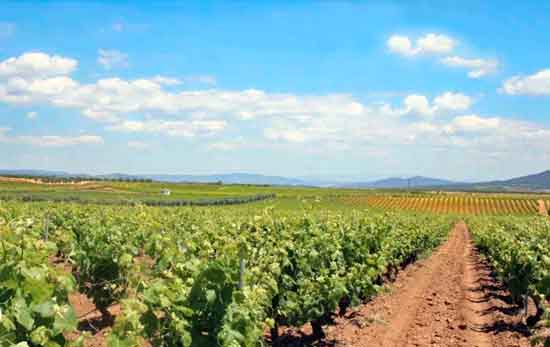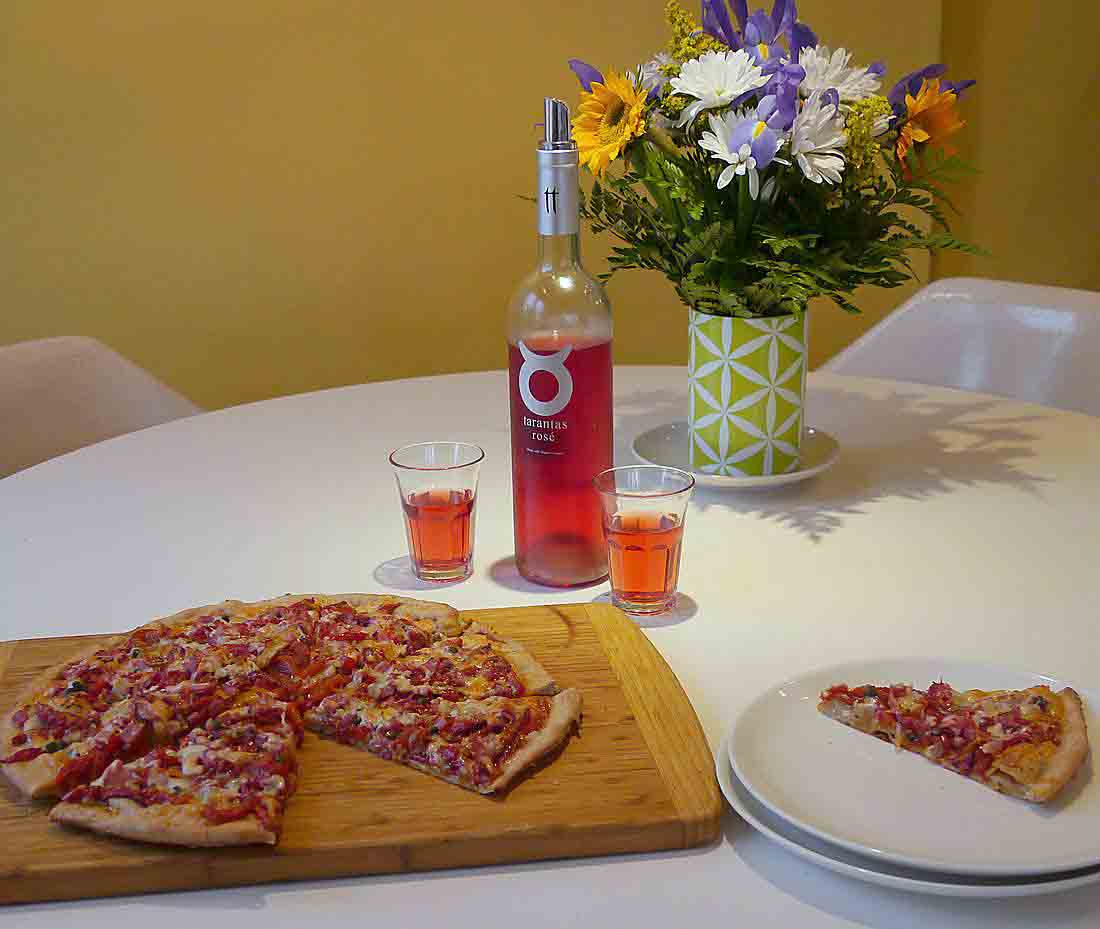
We’re convinced that there is nothing like taste to evoke memories of place. A sip of wine will call back the flavor of the food, the sun on our faces, the wobbly leg of the cafe table, and the street life around us. We’re just starting to taste several wines from the Utiel Requena region in the northwest corner of the autonomous region of Valencia. As we taste, we’re reliving trips to Catalunya, Aragón, Valencia, and the Balearic Islands. In addition to speaking variants of Catalan, these regions feature cuisines that pair very well with the Bobal wines of Utiel Requena. We’ll be enjoying them with some of our favorite dishes.
As shown in this photo just below, D.O. Utiel Requena sits in the rain shadow of mountains, so the region is dry and perfectly suited to organic growing. Most of the producers do grow organically, and they concentrate on the Bobal grape. That’s an indigenous red varietal found almost nowhere else—a great local grape for the cuisine. Historically, Bobal was overcropped and used for blending with wine from other Spanish regions. In the last generation, though, producers have taken advantage of the old vines—most on their own rootstock—to make wines with fabulous concentration and well-defined character.
A Bobal rosé—in this case Tarantas—makes a great complement to one of our favorite bar foods, coca, which is pizza-like flatbread topped primarily with red peppers. The lightly sparkling wine made entirely from Bobal has a strawberry nose and tangy red-currant and melon flavors in the mouth. The producer of Tarantas wines is Bodegas Iranzo (www.bodegasiranzo.com), a family concern that has been making wine in the region since 1335! The pronounced fruit of the rosé brings out the herbaceous quality of the pepper while emphasizing the caramel notes from cooking.
Barcelona’s best patio
We first tasted coca at an outdoor cafe table at La Vinya del Senyor, the wine bar that shares a plaza with the Basilica de Santa Maria del Mar. Pat wrote about it in her new book 100 Places in Spain Every Woman Should Go. The photo at the top of this post shows some folks having a good time—and a bottle of wine (of course).
 Funded and even partially built by the people of the neighborhood, Santa Maria del Mar (at right) was consecrated in 1384 and remains a perfect example of Catalan Gothic style. Its serene interior and popular appeal make it a favorite for society weddings. We spent a magical evening watching a bride and groom enter the church single and leave as a couple. They lingered in the plaza, surrounded by their boisterous friends, a group of street musicians, and a churlish taxi driver blasting his horn as he tried to no avail to break up the revelry.
Funded and even partially built by the people of the neighborhood, Santa Maria del Mar (at right) was consecrated in 1384 and remains a perfect example of Catalan Gothic style. Its serene interior and popular appeal make it a favorite for society weddings. We spent a magical evening watching a bride and groom enter the church single and leave as a couple. They lingered in the plaza, surrounded by their boisterous friends, a group of street musicians, and a churlish taxi driver blasting his horn as he tried to no avail to break up the revelry.
We’re not the only ones who are in love with this wine bar. In her cookbook The New Spanish Table, Anya von Bremzen sings the praises of the bar’s coca. We have adapted her recipe below.
COCA MALLORQUINA
Von Bremzen’s version is more purist, eschewing the cheese that makes a coca seem more like a pizza. But we like the small specks of jamón serrano and creaminess of melted Mahon, a Mallorcan semisoft cheese. The defining characteristic is the topping of slightly caramelized sweet red peppers. Use your favorite pizza dough recipe, but be sure to oil the pan and oil the surface of the dough. If you don’t have a favorite home recipe, see ours here: hungrytravelers.com/black-truffle-pizza-tricks.
Ingredients
olive oil
2 cloves of garlic, shaved thin
2 cups of strips from roasted and peeled sweet red peppers
peel of lemon, finely chopped
2 teaspoons sugar
juice of 1 lemon
1 lb. pizza dough
2 ounces jamón serrano, chopped
1 tablespoon capers
4 ounces Mahon cheese, grated
Directions
Set oven at 450°F.
Drizzle olive oil to cover base of heavy frying pan. Add garlic and fry until crisp. (This gives garlic flavor to the oil.) Remove garlic. Add peppers, lemon peel, and sugar. Sauté until peppers start to caramelize on surface. Add lemon juice and continue cooking until evaporated.
Spread dough on oiled pan (14-inch round or 11×17 sheet). Spread pepper mix evenly. Distribute pieces of crisp garlic evenly. Sprinkle with jamón, capers, and cheese.
Cook 8-10 minutes until crust begins to crisp.


